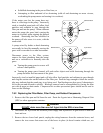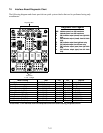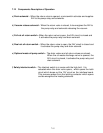
7-9
• Solidified shortening in the pan or filter lines, or
• Attempting to filter unheated oil or shortening (cold oil and shortening are more viscous,
overloading the pump motor and causing it to overheat).
If the motor runs but the pump does not,
there is a blockage in the pump. Incorrectly
sized or installed paper/pads will allow food
particles and sediment to pass through the
filter pan and into the pump. When sediment
enters the pump, the gears bind, causing the
motor to overload, again tripping the thermal
overload. Shortening that has solidified in
the pump will also cause it to seize, with the
same result.
A pump seized by debris or hard shortening
can usually be freed by manually moving the
gears with a screwdriver or other instrument.
Disconnect power to the filter system,
remove the input plumbing from the pump,
and use a screwdriver to manually turn the
gears.
● Turning the pump gears in reverse will
release a hard particle.
● Turning the pump gears forward will push softer objects and solid shortening through the
pump and allow free movement of the gears.
Incorrectly sized or installed paper/pads will also allow food particles and sediment to pass through
and clog the suction tube on the bottom of the filter pan. Particles large enough to block the suction
tube may indicate that the crumb tray is not being used. Pan blockage can also occur if shortening is
left in the pan and allowed to solidify. Blockage removal can be accomplished by forcing the item
out with an auger or drain snake. Compressed air or other pressurized gases should not be used to
force out the blockage.
7.8.2 Replacing the Filter Motor, Filter Pump, and Related Components
1. Remove the filter pan and lid from the unit. Drain the frypots into a Shortening Disposal Unit
(SDU) or other appropriate container.
DANGER
DO NOT drain more than one full frypot into the SDU at one time.
2. Disconnect the fryer from the electrical power supply and reposition it to gain access to both the
front and rear.
3. Remove the two lower back panels, unplug the wiring harnesses from the contactor boxes, and
remove the two screws that secure one of the boxes in place (it doesn’t matter which one; see
Sediment Particle
Oil Flow
Up for reverse
Down for forward
Sediment Particle


















